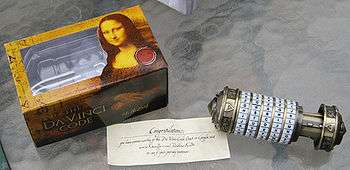Cryptex

The word cryptex is a neologism coined by the author Dan Brown for his 2003 novel The Da Vinci Code, denoting a portable vault used to hide secret messages. It is a portmanteau word formed from Greek κρυπτός kryptós, "hidden, secret" and Latin codex; "an apt title for this device" since it uses "the science of cryptology to protect information written on the contained scroll or codex" (p. 199 of the novel). The first physical cryptex was created by Justin Kirk Nevins in 2004.[1][2]
Design and function
The (first) cryptex featured in the novel is described as a stone cylinder comprising "five doughnut-sized disks of marble [that] had been stacked and affixed to one another within a delicate brass framework"; end caps make it impossible to see inside the hollow cylinder. Each of the disks is carved with the entire alphabet (it is not clear whether the U/V and I/J distinctions are preserved or whether W is included) and can be rotated independently of the others to create different letter-alignment combinations, including but not limited to words, initialisms, and anagrams. Although it is not clear whether the alphabet in question preserves the U/V and/or I/J distinctions and/or includes the letter W, when only the alignment of the disks with respect to each other is considered, the number of potential combinations is between 23^4 (279,841) and 26^4 (456,976); if the mechanism treats combinations having the same disk alignment but different degrees of rotation around the cylinder's long axis as distinct, as does a multiple-wheel combination lock or slot machine employing an indicator bar along which the specified numbers are to be aligned, this number rises to between 23^5 (6,436,343) and 26^5 (11,881,376).
The cryptex works "much like a bicycle's combination lock", and if one arranges the disks to spell out the correct password, "the tumblers inside align, and the entire cylinder slides apart" (p. 200). In the inner compartment of the cryptex, secret information can be hidden, written on a scroll of thin papyrus wrapped around a fragile vial of vinegar as a security measure: if one does not know the password but tries to force the cryptex open, the vial will break and the vinegar will dissolve the papyrus before it can be read.
In popular culture
- In Season 4, episode 14 of the TV series Parks and Recreation Ron helps Ben open up a Cryptex that Leslie has given in an elaborate Valentine's Day scavenger hunt.
- In Season 2 episode 4, The Brothers Grimoire, of the Lifetime TV series Witches of East End, a Cryptex® Security Box is given to Dash and Killian as their inheritance from their mother.
- On the NBC reality series Treasure Hunters, nested Cryptex® Security Boxes were among the puzzles that challenged contestants, and were used in the finale.
- In Season 3 of the TV series Eureka, in the episode "Phased and Confused", a nearly-unbreakable cryptex is the key to a hidden underground bunker.
- In episode 88 of the South Korean variety show Running Man, the cast members had to find clues attached to other staff members to open their cryptex.
- In "Down the Rabbit Hole", a fourth season episode of the American TV series The Vampire Diaries, depicts a sword with a cryptex device under its hilt.
See also
- Combination lock
- Wordlock, a combination lock using letters instead of numerals
- Jefferson disk, a cipher-encoding device mechanically similar to a cryptex
References
- ↑ Caine, Peter (2006). The Definitive Guide to the Da Vinci Code. Orion.
- ↑ "US Patent & Trademark Office". Retrieved 2004. Check date values in:
|access-date=(help)
- The Da Vinci Code
- Da Vinci Declassified, 2006 TLC video documentary, written, directed and produced by David Carr, David Comtois, and Frankie Glass. Narrated by Jeff Fischer.